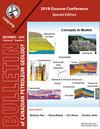Geochemistry and distribution of biogenic gas in China
Q3 Earth and Planetary Sciences
引用次数: 3
Abstract
Of twenty-nine known biogenic gas fields in China, three with reserves of nearly 100 × 109 m3 are located in Qaidam Basin, western China, and two with reserves of 50 × 109 m3 are located in Yinggehai Basin, southern China. The other fields, concentrated in eastern and south-eastern China, have smaller reserves. The gas geochemical characteristics, including data from more than 300 gas samples, over 200 isotopic analyses and 12 inert gas analyses, reveals the following. Gases are predominated by methane (CH4) (95%), followed by nitrogen (N2; 0–15%) and carbon dioxide (CO2; <3% but commonly <1%). Methane δ13C1 values are very light, usually <−55‰. The ethane δ13C2 values range widely from −60‰ to −20‰ and the δ13CCO2 values are between −39‰ and 5‰. Hydrogen isotope values of CH4 range from −260‰ to −190‰, which indicate that the gases are formed by CO2 reduction. 3He/4He ratios are between n × 10−8 and n × 10−7. 40Ar/36Ar ratios are between 231 and 439 and R/Ra ratios are 0.03. These biogenic gases exhibit geochemical characteristics and occur in geological settings that indicate two major biogenic gas types in China: early, or primary, biogenic gas and secondary biogenic gas that formed through crude oil biodegradation. Primary biogenic gas reserves are large while secondary biogenic gas reserves are smaller but widely distributed. The geological settings of the two types differ significantly. The primary biogenic gases are concentrated in Cenozoic successions characterized by rapid sedimentation, high organic matter content and syndepositional entrapment. Most secondary biogenic gases are associated with biodegraded heavy oil occurrences and these are not confined to any specific sedimentary strata or epoch.中国生物气地球化学特征及分布
在中国已知的29个生物气田中,储量接近100 × 109 m3的有3个位于西部柴达木盆地,储量50 × 109 m3的有2个位于南部莺歌海盆地。其他油田集中在中国东部和东南部,储量较小。气体地球化学特征,包括来自300多个气体样本的数据,200多个同位素分析和12个惰性气体分析,揭示了以下几点。气体以甲烷(CH4)为主(95%),其次是氮(N2);0-15%)和二氧化碳(CO2;<3%,但通常<1%)。甲烷δ13C1值很轻,通常< - 55‰。乙烷δ13C2值在−60‰~−20‰之间,δ13CCO2值在−39‰~ 5‰之间。CH4的氢同位素值在−260‰~−190‰之间,表明气体是由CO2还原形成的。3He/4He比值在n × 10−8 ~ n × 10−7之间。40Ar/36Ar比值介于231和439之间,R/Ra比值为0.03。这些生物气具有地球化学特征,赋存的地质环境表明中国主要有两种生物气类型:早期或原生生物气和原油生物降解形成的次生生物气。原生生物气储量大,次生生物气储量虽小,但分布广泛。两种类型的地质背景差异较大。原生生物气主要集中在以快速沉积、高有机质含量和同沉积圈闭为特征的新生代层序中。大多数次生生物成因气体与生物降解稠油产层有关,这些产层不局限于任何特定的沉积地层或时代。
本文章由计算机程序翻译,如有差异,请以英文原文为准。
求助全文
约1分钟内获得全文
求助全文
来源期刊

Bullentin of Canadian Petroleum Geology
Earth and Planetary Sciences-Geochemistry and Petrology
CiteScore
2.50
自引率
0.00%
发文量
0
期刊介绍:
The Bulletin of Canadian Petroleum Geology is a peer-reviewed scientific journal published four times a year. Founded in 1953, the BCPG aims to be the journal of record for papers dealing with all aspects of petroleum geology, broadly conceived, with a particularly (though not exclusively) Canadian focus. International submissions are encouraged, especially where a connection can be made to Canadian examples.
 求助内容:
求助内容: 应助结果提醒方式:
应助结果提醒方式:


